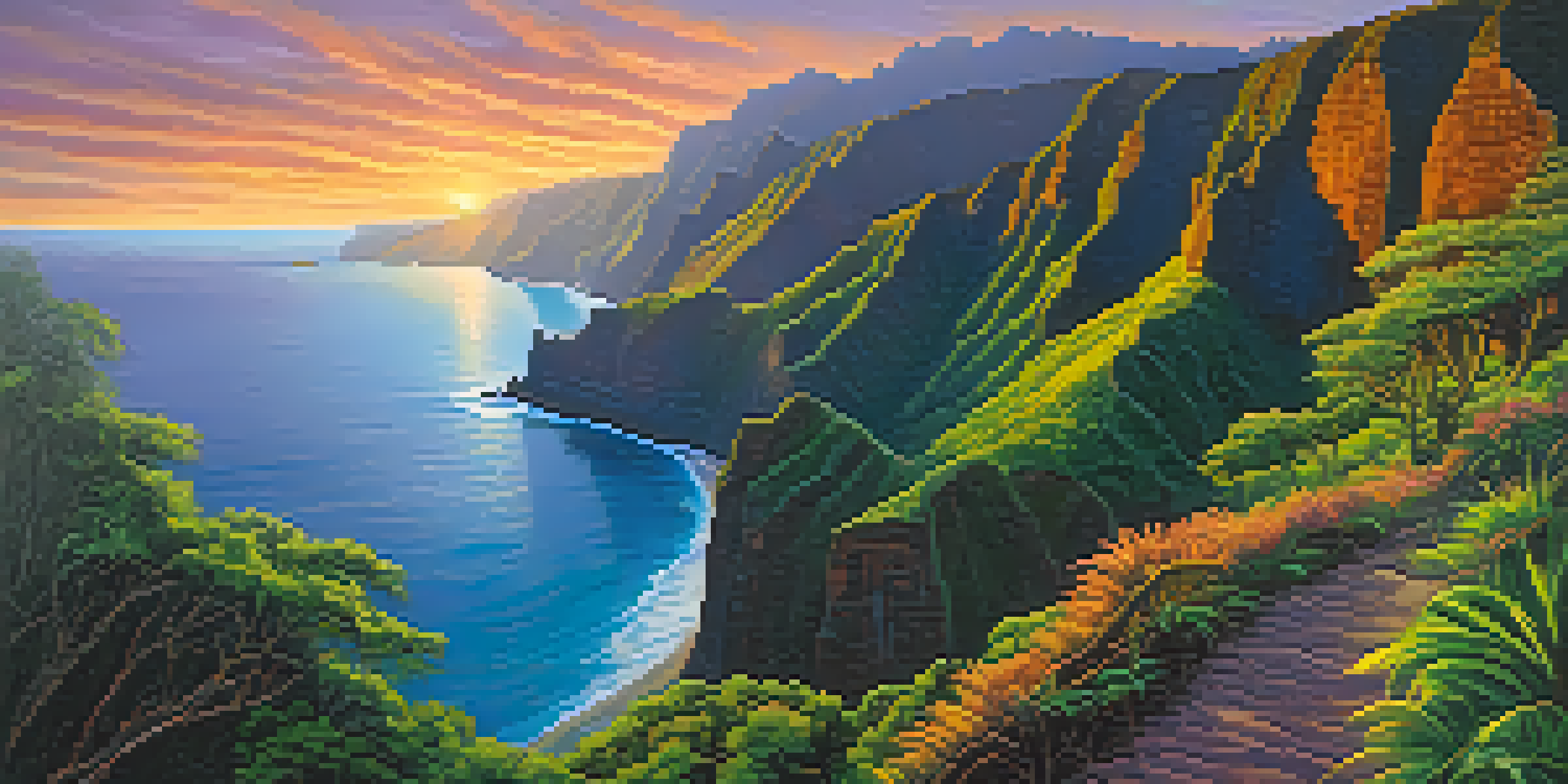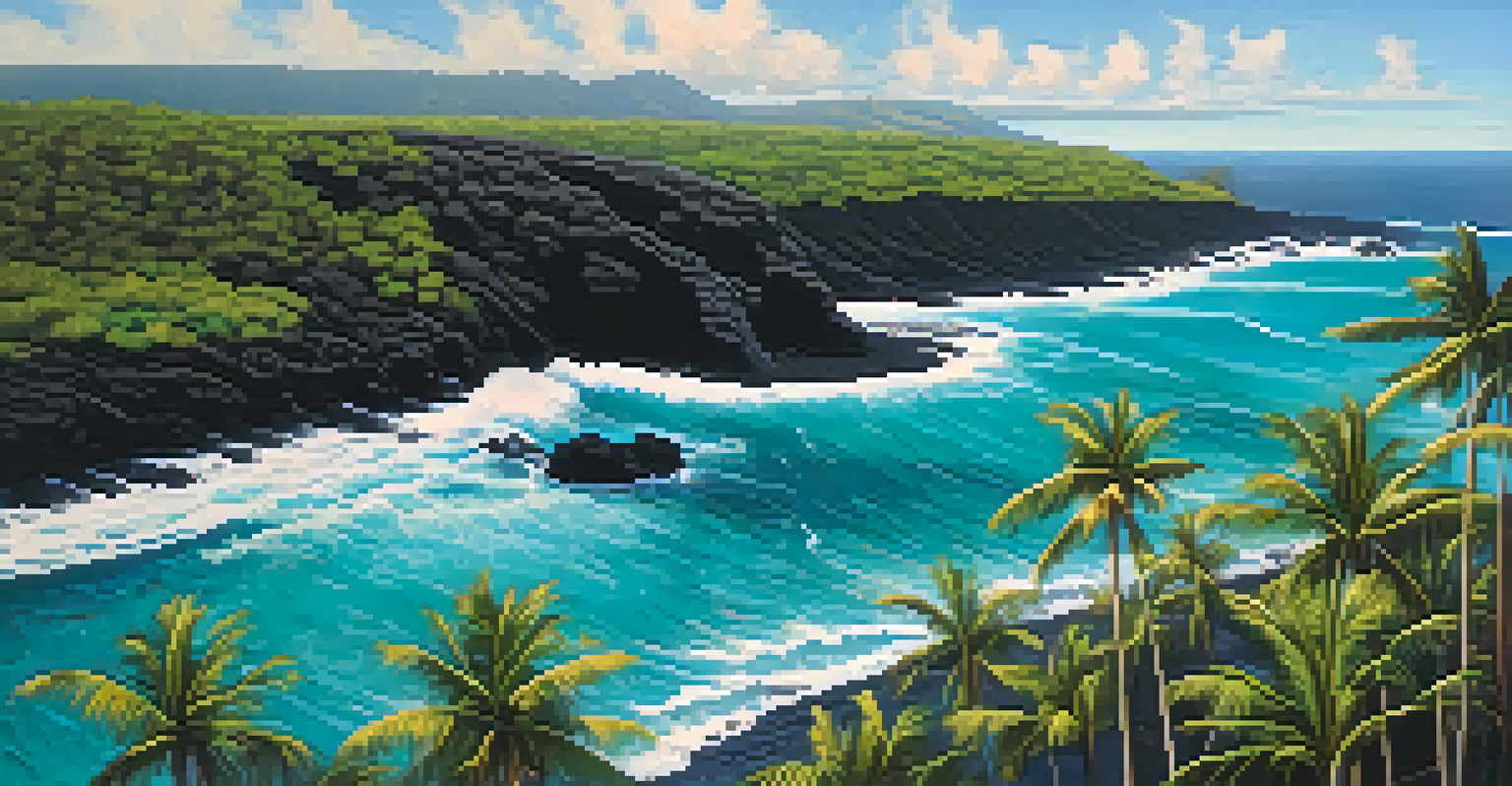Exploring Hawaii's Unique Geological Features and Landscapes

The Formation of Hawaii: A Volcanic Symphony
Hawaii's islands were born from volcanic activity, creating a unique geological landscape. The Hawaiian hotspot, a plume of molten rock, has produced some of the world's most active volcanoes, including Kilauea and Mauna Loa. Over millions of years, these eruptions built up the islands we see today, each with its own distinct features and characteristics.
The earth has music for those who listen.
Imagine the earth's crust like a giant sponge, with molten lava bubbling up through it. As the lava cools, it forms new land, constantly reshaping the islands. This dynamic process not only creates stunning landscapes but also contributes to Hawaii's rich biodiversity, as new habitats emerge from the cooling lava.
The volcanic nature of Hawaii means that its landscapes are constantly evolving. From jagged cliffs to expansive lava fields, each area tells a story of the earth's relentless power and transformation, inviting visitors to explore its ever-changing beauty.
Diverse Ecosystems: A Natural Laboratory
Hawaii is often described as a living laboratory due to its diverse ecosystems. From lush rainforests to arid deserts, the islands boast a variety of climates and habitats, each supporting unique flora and fauna. This diversity is a result of Hawaii's isolation and varied topography, which have allowed species to evolve in remarkable ways.

Consider the native Hawaiian honeycreepers, birds that have adapted to the islands' distinct environments. Each species has developed unique traits to thrive in specific habitats, showcasing the power of evolution in action. This makes Hawaii a crucial place for studying biodiversity and conservation efforts.
Hawaii's Volcanic Origins
The islands of Hawaii were formed by volcanic activity, driven by the Hawaiian hotspot, resulting in diverse geological landscapes.
Exploring these ecosystems offers a glimpse into the delicate balance of nature. As you hike through the forests or stroll along the beaches, you can witness firsthand how geology and biology intertwine to create a vibrant tapestry of life.
The Majestic Volcanoes: Nature's Powerhouses
The volcanoes of Hawaii are not just geological wonders; they are also central to the islands' culture and history. Each volcano, like Mauna Kea and Haleakalā, holds significance in Hawaiian mythology and is revered by locals. Their towering presence serves as a reminder of the powerful forces that shaped the landscape.
In every walk with nature one receives far more than he seeks.
Visitors often find themselves in awe of the breathtaking views from these volcanic peaks. From the summit of Mauna Kea, you can see the stars more clearly than almost anywhere else on Earth, thanks to its high elevation and low light pollution. This connection between the land and the cosmos adds another layer of wonder to Hawaii's volcanic landscapes.
Moreover, these volcanoes create unique opportunities for adventure. Whether you're hiking through volcanic craters or witnessing the dramatic lava flows, the experiences are both thrilling and educational, allowing you to appreciate the raw beauty of nature.
Stunning Coastlines: Nature’s Sculpted Art
Hawaii's coastlines are a testament to the relentless power of the ocean. The waves crashing against the volcanic rock have sculpted dramatic cliffs, hidden coves, and pristine beaches, creating some of the most picturesque scenery in the world. Each shoreline has its own character, from the black sand beaches of Punalu'u to the golden shores of Waikiki.
Take a moment to picture the contrast of colors: the deep blue of the ocean against the stark black of lava rock. This visual feast is not just for the eyes; it also supports a diversity of marine life. Coral reefs thrive in these waters, offering vibrant ecosystems that are vital to ocean health.
Biodiversity and Unique Ecosystems
Hawaii's isolation has led to the evolution of unique species and ecosystems, making it a vital area for studying biodiversity.
Exploring Hawaii's coastlines invites visitors to engage with nature in a multitude of ways, from snorkeling among colorful fish to simply soaking in the sun on the beach. Each experience is a reminder of the intricate relationship between land and sea.
Unique Geological Formations: Nature's Sculptures
Hawaii is home to some truly unique geological formations that stand as natural sculptures. Places like the Na Pali Coast, with its towering sea cliffs, or the otherworldly landscapes of Haleakalā National Park, showcase nature's artistic capabilities. These formations tell stories of erosion, volcanic activity, and the passage of time.
Imagine hiking along the rugged trails of the Na Pali Coast, where steep cliffs plunge into the ocean below. The views are often breathtaking, with lush green valleys and cascading waterfalls adding to the drama of the landscape. Each turn on the trail reveals a new perspective of these stunning formations.
These geological features are not just beautiful; they are also essential for understanding Earth's history. Studying how these formations came to be provides valuable insights into geological processes, helping us appreciate the planet's story and our place within it.
Cultural Connections: The Spirit of Aloha
The geological features of Hawaii are deeply intertwined with its cultural identity. The native Hawaiian people hold a profound connection to the land, viewing it as a source of life and inspiration. Many sites, such as sacred mountains and ancient heiaus (temples), reflect this bond and are integral to their cultural heritage.
For instance, Mauna Kea is not just a mountain; it is considered a sacred place by many Hawaiians. The cultural practices and stories associated with such sites enrich the experience of exploring the islands, adding layers of meaning to the stunning landscapes.
Cultural Significance of Nature
The natural features of Hawaii are deeply connected to its cultural identity, with sacred sites that reflect the spiritual bond between the land and its people.
This connection encourages visitors to approach Hawaii with respect and understanding. Engaging with local traditions and learning about the history of the land fosters a deeper appreciation for the islands, transforming a simple visit into a meaningful journey.
Conservation Efforts: Protecting Hawaii's Treasures
As a paradise of unique geological features and diverse ecosystems, Hawaii faces the challenge of conservation. The delicate balance of its natural environments is threatened by climate change, invasive species, and human activity. Efforts are underway to protect these treasures, ensuring they endure for future generations.
Organizations and local communities are working hand in hand to restore habitats and promote sustainable tourism. These initiatives not only aim to protect the islands' natural beauty but also educate visitors about their role in conservation. Simple actions, like staying on marked trails or supporting local conservation efforts, can make a significant impact.

Visiting Hawaii offers a chance to connect with nature while contributing to its preservation. By understanding the challenges the islands face, travelers can leave with a sense of responsibility, knowing they played a small part in protecting this extraordinary environment.